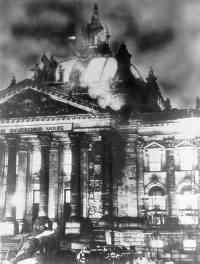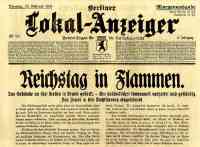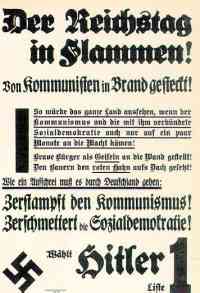Burning the Reichstag
On the 27. February in 1933, one month after Adolf Hitler was declared Reichskanzler, the Reichstags-building in Berlin was burning.
As well as Marinus van der Lubbe the German police charged four communists with setting fire to the Reichstag. This included Ernst Torgler, the chairman of the KPD and Georgi Dimitrov of the Soviet Comintern.
Marinus van der Lubbe was found guilty of the Reichstag Fire and was executed on 10th January, 1934. Adolf Hitler was furious that the rest of the defendants were acquitted and he decided that in the future all treason cases were to be taken from the Supreme Court and given to a new People's Court where prisoners were judged by members of the National Socialist German Workers Party (NSDAP).
The burning of the Reichstag was very useful for the German Government. On the 28. of February, the Reichstagsbrandverordnung (similiar to Patriot Act) was set in power.
This Decree of the Reich President for the Protection of the People and State abrogates the following constitutional protections.
- Free expression of opinion
- Freedom of the press
- Right of assembly and association
- Right to privacy of postal and electronic communications
- Protection against unlawful searches and seizures
- Individual property rights
- Federal States' right of self-government
A supplemental decree creates the SA (Storm Troops) and SS (Special Security) Federal police agencies.
ANALYSIS
The events in 1933 can be summarized as follows:
- While it is not clear whether the Nazis intentionally set the Reichstag fire in order to create a national crisis, or whether the Nazis simply were opportunistic, the event was used as justification for a sharp curtailment in constitutionally guaranteed civil liberties.
- The Nazis took advantage of the additional Federal police powers to suppress opponents.
- It is clear that in other situations, the Nazis did use the tactic of creating a "law and order" crisis so that they could provide a solution which further eroded civil liberties and entrenched their power.
- The right-wing Nazis and the left-wing communists were cut from the same cloth -- the point is not that the far right destroyed civil rights. Rather, the point is that a democracy can be destroyed by creating a law-and-order crisis and offering as a 'solution' the abdication of civil liberties and state's rights to a powerful but unaccountable central authority.
Related SourceWatch articles
External resources
- "Reichstag Fire Decree", GermanNotes History, accessed September 2007.


